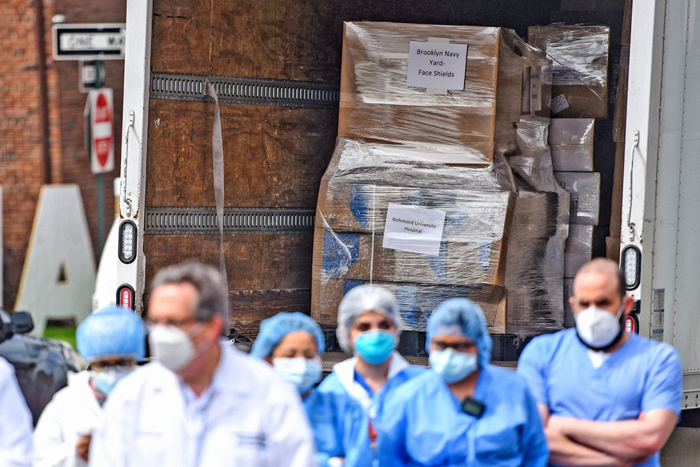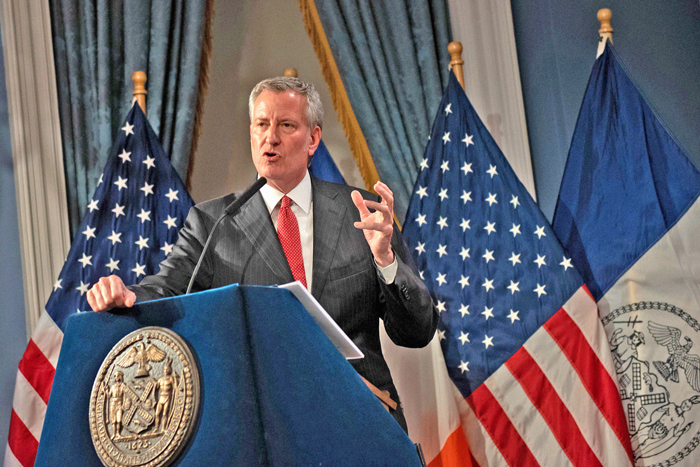Photo Courtesy of Michael Appleton/Mayoral Photography Office
According to Mayor de Blasio, the $89 billion Executive Budget was “crafted in light of immense fiscal hardship.”
By Michael V. Cusenza
Mayor Bill de Blasio on Thursday detailed the City’s Executive Budget for Fiscal Year 2021—a balanced $89 billion spending plan that was, according to Hizzoner, “crafted in light of immense fiscal hardship.”
Facing a staggering $7.4-billion tax revenue hit across FY2020 and FY2021, the administration slashed and burned the budget by $3.4 billion, compared to the FY2020 plan that was adopted in June 2019.
As expected, the economic fallout from the COVID-19 pandemic has its fingerprints all over the budget. According to the City, to date, it has spent more than $700 million to fight COVID-19, with the expectation of spending $3.5 billion on it by the end of the calendar year. This includes more than $170 million to make sure that no one goes hungry; this is in addition to food security investments the City traditionally makes. Health + Hospitals, the largest public health system in the country, has felt the full weight of the pandemic, adding $100 million to increase staffing, and support the agency’s efforts to save lives and prevent the virus from spreading further. To protect New Yorkers who are actively fighting this outbreak, the City has spent almost $200 million in Personal Protective Equipment. And to support small businesses that are facing extreme economic hardship, the administration has allocated $50 million in grants and loans to help them get through the tough times.
According to de Blasio, in order to balance the budget while prioritizing critical needs, the administration has achieved savings of $2.7 billion across FY2020 and FY2021. This includes Program to Eliminate the Gap(mandatory savings program that includes agency budget cuts, programmatic cuts, and a hiring freeze) savings of $2.1 billion ($600 million recurring annually) and $550 million in citywide savings ($220 million recurring annually).
These are pauses and adjustments to critical programs that cannot operate during this time of crisis, the mayor explained. Administration officials saidthey have adjusted operational programs to ensure there is no gap in necessary services and will reevaluate as soon as we have navigated through the pandemic.
PEG cuts over two years include:
- Fair student funding reduction prioritizing schools that already have over 100 percent (DOE) – $100M in FY21
- Operational savings in training, overtime, and materials at schools, central and field due to school building closures (DOE) – $100M in FY20
- Professional Development reduction (DOE) – $67M in FY21 and outyears
- Cuts to Summer in the City, Single Shepherd, College Access for All (DOE) – $49M in FY21 and outyears
- Delay in 3K Expansion to districts in 1, 12, 14, and 29 (DOE) – $43M in FY21
- Reducing the ATR pool by implementing a non-ATR hiring freeze (DOE) – $40M in FY21 and outyears
- Temporary reduction of School Allocation Memoranda, which provides schools with funding to implement programming (DOE) – $40M in FY21
- Temporary delay of new cohort of freshmen for CUNY ASAP program (CUNY) – $20M in FY21
- Contract and supply reductions associated with arts programming in middle and high schools (DOE) – $15.5M in FY21 and outyears
- Savings from delayed installation of air conditioners (DOE) – $10M in FY21
- Monthly MetroCard underutilization for remaining 2 months of academic year (CUNY) – $6.8M in FY20
- Eliminate District/Charter Partnerships program – $4.4M in FY21 and outyears
- Eliminate supplies and materials used in Civics for All curriculum and programming (DOE) – $3.8M in FY21 and outyears
- Adjustments to SONYC Afterschool budget (DOE) – $5M in FY21 and outyears
- Savings achieved from anticipated low summer enrollment in CUNY Start Math program (CUNY) – $800K in FY20 and $1.6M in FY21
- Scaling down contracts, technology curriculum and health education certification programming for teachers (DOE) – $1.8M in FY21 and outyears
- Temporary suspension of Summer Youth Employment Program (DYCD) – $124M over FY20- 21
- Delayed April NYPD Cadet class until July due to training restrictions from COVID-19 (NYPD) – $1.1M IN FY20
- Delayed April NYPD Officer class until July due to training restrictions from COVID-19 (NYPD) – $9.6M IN FY20
- Fair Fares decline in ridership as a result of COVID-19 (DSS) – $65.5M in FY20
- Reduction to tree and sidewalks program given delays to non-essential work – $6M in FY21
- Reduction in Tree Pruning – contract reduction (retaining emergency capacity) $5.7M in FY21
- Reduction of Tree Stump Removal Program – contract reduction – $1M in FY21

Photo Courtesy of Michael Appleton/Mayoral Photography Office
To date, the City has spent more than $700 million to fight COVID-19, with the expectation of spending $3.5 billion on the virus by the end of the calendar year.
Some cuts did not cultivate any fans of Hizzoner.
“[The Summer Youth Employment] Program should be treated as an essential program in the City budget,” Assemblywoman Stacey Pheffer Amato (D-Howard Beach) said. “We should not penalize students who are trying to gain life skills, develop as professionals, and put a little money in their pockets. Instead of cutting this program, we should be modernizing it to meet the moment that we’re in. There are businesses in this city still operating, and could employ workers that are subsidized by the city and state government now more than ever. If regular employees are able to work from home and remotely, we should allow SYEP students to as well.”
City Comptroller Scott Stringer said the new spending plan is another siren call to Washington for much-needed help.
“In this public health emergency there is nothing more important than providing for the most vulnerable New Yorkers—communities of color, immigrants, seniors, and those experiencing homelessness. The mayor’s budget relies on a mix of savings, reserves, and federal stimulus funds to maintain a balanced budget. A more robust savings program in prior years would have helped to build up a bigger cushion to protect against cuts that will be devastating in particular to New York City’s youth,” Stringer said. “What is abundantly clear, however, is that in order for us to get on our strongest fiscal footing, we need the federal government to step up. New York City is both the epicenter of this crisis and the financial capital of the country. The national recovery starts here, and the federal government needs to provide wide-ranging, robust financial support in recognition of our central role.”

